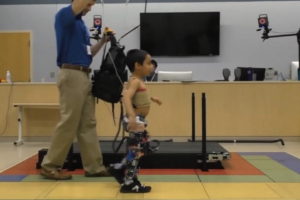Exoskeleton Designed to Enhance Walking of Children with Cerebral Palsy
Scientists from the NIH Clinical Center Rehabilitation Medicine Department have made the first automatic exoskeleton particularly developed to take care of flexed-knee or crouch gait in kids facing cerebral palsy by offering power-driven knee extension help at important stages at the time of the walking cycle.
Crouch gait, the extreme twisting of the knees during walking, is a debilitating and common condition in kids facing cerebral palsy. In spite of traditional treatments (comprising surgery, muscle injections, orthotics, and physical therapy,), crouch gait can result in a progressive deterioration of the walking function, eventually leading to the loss of ability of walking in almost 50% of adults with the illness.
In a cohort study, the researchers at NIH Clinical Center examined their sample power-driven knee exoskeleton to:
- Verify if extension assistance of power-driven knee effectively and safely lowered crouch gait while walking in ambulatory kids facing cerebral palsy.
- Calculate its impact on activity of voluntary muscle to verify if kids carried on to utilize their own muscles while walking with support.
- Enumerate short-term modifications in gait biomechanics of lower limb in reaction to extension assistance of power-driven knee.
The study followed 7 people in the age between 5 and 19 who were having Gross Motor Function Classification System levels I-II and were identified with crouch gait facing cerebral palsy, indicating each might walk minimum 30 Feet with no use of a walking assistance.
Walking with assistance of exoskeleton was well-beard with all candidates capable of walking separately with no therapist assistance or mobility aids with 6 doing so in the initial session of practice. Enhancements in knee extension were noticed in 6 members with gains (8–37°) analogous to or more than average enhancements reported from interventions by invasive surgical. Prominently, the knee extension gains took place with no decrease in muscle activity of knee extensor, representing that these members worked with the exoskeleton more willingly than offloading the job of unbending the leg while walking with the robot.
“Almost all the wearable exoskeletons have been developed for people suffering from paralysis, with the exoskeleton restoring the lost purpose of the users. We looked to make a gadget that might effectively and safely enhance the bearing of kids with crouch gait at the time of walking,” claimed Ph.D., the chief investigator of the study, Thomas Bulea, to the media in an interview. Bulea is also a staff scientist in the NIH Clinical Center Department of Rehabilitation Medicine.

